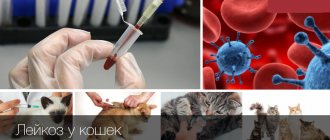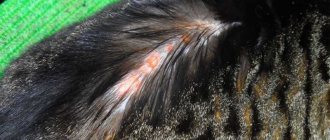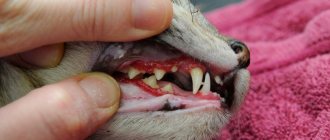Coughing attacks, difficulty breathing, wheezing, shortness of breath - this is it, feline asthma. How? Do cats have asthma just like people?! Yes, there is, and it is very similar to a human one. And the disease is not that rare - it occurs in approximately 1% of cats of all ages (usually after 2-3 years) and in all countries.
Bronchial asthma is a chronic inflammatory disease of the airways. But if in bronchitis the respiratory tract infection is bacterial in nature, then in asthma the narrowing of the bronchi is based primarily on the allergic mechanism, and the infection can be secondary.
Thank you for watching!
If you liked the video, share it with your friends:
Asthma (from the Greek asthma - heavy breathing, suffocation) is an allergic disease with repeated attacks of suffocation due to spasm of the bronchi and swelling of their mucous membrane.
That is, bronchial asthma is based on allergies - increased sensitivity of the body, including bronchial tissues, to various allergens - substances that are normally perceived as harmless.
Bronchial asthma in cats: general information
As a rule, symptoms of an asthma attack in felines are caused by inhalation of an allergic substance that causes inflammation in the lungs. When an animal breathes in an allergen, the body interprets it as a danger to the immune system and launches a reaction against the aggressive antigen. As a result of this reaction, the airways narrow and mucus accumulates in them.
Allergens and their sources for cats and kittens
Accordingly, during an attack, the animal may cough, wheeze, and breathe heavily. This is due to narrowing and swelling of the walls of the respiratory tract, therefore, with a lack of air. In addition to acute attacks, there are also chronic symptoms. The owner may notice that the pet's breathing has changed - instead of silent it has become gurgling or whistling. Such “sound effects” are a reason to be wary.
Normally, a cat breathes silently - even at close range it is difficult to hear the sound of breathing
Similar to how asthma occurs in humans, in cats this disease is chronic. In addition, it is almost impossible to get rid of the disease forever. But with competent and timely diagnosis and correctly prescribed therapy, it is possible to achieve stable remission in the animal, and therefore improve the quality of life.
The owner must understand that the mustachioed pet will be prescribed the appropriate medications for life. However, there is nothing wrong with this - treatment for feline asthma does not cause the animal pain, and both the animal and its owner quickly get used to frequent manipulations. Thus, the therapy will not burden the person, cause serious discomfort to the pet and take a lot of time.
An animal diagnosed with asthma should be treated with care and care.
Treatment and prognosis
It should be understood that even with timely detection of symptoms and treatment of feline viral leukemia, animals have virtually no chance of complete recovery. This is due to the lack of specific drugs that can have a detrimental effect on the pathogen without destroying the healthy cells of the pet’s body.
Therefore, veterinary specialists prescribe drugs for symptomatic therapy, based on the individual characteristics of cats, the localization of the pathology and the severity of the clinical manifestations of viral leukemia. Among them are:
- immunomodulators aimed at stimulating the synthesis of animals’ own immune factors (Alpha-interferon, Feliferon, Betaleikin, Gala-vet, Roncoleukin);
- chemotherapy drugs (Cyclophosphamide, Vincristine), which are administered to reduce the size of malignant tumors or prevent the development of metastases after tumor removal;
- antibiotics are prescribed to prevent the development of secondary infections against the background of a decrease in general resistance (penicillin drugs, cephalosporins);
- mineral and vitamin complexes.
Whenever possible, cats undergo removal of malignant tumors, as well as blood transfusions and passive administration of antibodies from donor animals.
Causes of Asthma in Felines
Modern veterinary medicine is unable to give a clear answer to the question: “What is considered the root cause of asthma in cats?” But, despite the insufficient knowledge of the etiology of this feline disease, it is precisely established that the key factor that provokes the disease is an allergic reaction.
Veterinarians name a number of reasons that can provoke an asthmatic attack in cats. These include:
- Frequent stressful situations.
- Heredity (a parent couple where at least one animal suffers from asthma has a high probability of giving birth to kittens with a predisposition to the disease).
- Breed disposition (it is believed that Siamese and Himalayan cats, as well as their crosses, are more susceptible to the disease than others).
- Viral and infectious diseases left without appropriate treatment.
- Non-infectious diseases that affect the pet's respiratory system.
- Allergens that constantly affect the animal (cigarette smoke, dust, chemical fumes, pollen, parasites living on the skin).
From the very first days, the kitten in the house must be protected from exposure to harmful substances (tobacco, chemicals)
At the same time, the age factor is not decisive - asthma can develop in both a kitten and an elderly animal. But the seasonality of the disease does occur. In felines, as in humans, seizures tend to become more frequent at certain times of the year (spring) and in certain areas or weather conditions.
Asthma in cats: stages of development
Bronchial asthma occurs and manifests itself differently in animals, and based on the intensity of the attacks and the threat to the life and health of the pet, three stages of the development of the disease are distinguished.
Table. Stages of feline asthma
| Soft stage | Middle stage | Heavy stage |
| Seizures occur infrequently (perhaps once a month), last less than a minute, and the animal quickly recovers on its own. At this stage, the owner may not even suspect that the pet is suffering from bronchial asthma, especially if attacks occur while family members are away from home | Asthmatic attacks are still quite rare, but they are accompanied by more severe symptoms. This condition is dangerous to the health of the animal. | At this stage, seizures threaten the animal's life. If you do not pay attention to the symptoms and do not take therapeutic measures, the cat may suffocate and die at the highest point of the attack. |
At the first asthmatic attacks, the animal should be shown to a veterinarian
The task of a responsible owner is to prevent feline asthma from progressing to a severe stage that is life-threatening to the animal. Therefore, at the first symptoms, the cat should be taken to the veterinarian, since it can be not only about treating the pet, but also saving its life.
Diagnostic methods
The similarity of some symptoms in bronchial asthma with other diseases does not allow a diagnosis to be made based on a general visual examination of the animal, so a number of diagnostic examinations are recommended.
These include:
- determination of helminthic infestations in the pulmonary and cardiac spheres;
- identifying symptoms of acute respiratory viral infection;
- examination of the pleural area to identify diseases;
- examining the animal for the presence of foreign bodies in the larynx;
- blood sampling for general analysis. If the test results indicate an increased number of eosinophils, this may indicate asthma in the animal;
- in some cases, smears and cultures are taken from the tracheobronchi and feces are analyzed for helminths;
- Carrying out radiography to detect pneumonia and acute bronchitis. Bronchial asthma is diagnosed based on the results of radiography. An x-ray shows significant thickening of the bronchial walls and a distended diaphragm. However, sometimes with an “erased” form of the disease, radiography may not show obvious signs of bronchial asthma, which requires additional laboratory examination.
Carrying out a more accurate diagnosis allows us to identify the severity of asthma and prescribe adequate treatment for the animal.
Symptoms of feline asthma
Signs of asthma are differentiated from other respiratory tract ailments, viral infections, heart failure, and even foreign bodies entering the animal’s respiratory organs. However, the owner must be able to distinguish asthma both from another disease and from an episodic danger or even a physiological process. Thus, an attack of bronchial asthma in a cat can be confused with regurgitation of fur or a moment when the animal chokes on food or another object. Below we will tell you what symptoms distinguish the disease in question.
It is important to understand in time why the animal feels bad
Feline asthma attacks have characteristics that you need to pay attention to. Firstly, the disease manifests itself with some frequency and the owners note that the animal suddenly “gets worse” against the background of excellent health. Secondly, asthmatic attacks are insidious because in the intervals between them the cat continues to feel good: eats, plays, looks cheerful.
During an asthma attack, your cat appears to be choking and suffocating.
During the attack itself, as well as before and after it, people around the animal can observe the following:
- The cat looks worried, rushes around the room, cannot find a place for itself.
- When an attack occurs, the animal takes a characteristic pose - the paws are bent, the head is lowered, the cat breathes with its mouth open.
- Choking occurs unexpectedly for a cat, so it can experience an attack in any place where it finds it.
- The cat coughs violently, breathing comes out with wheezing and whistling.
- After an attack, the cat looks tired, lethargic, refuses food and communication with the owner.
Video - Cat cough
How to help a cat with an asthmatic attack?
A person experiencing an attack of bronchial asthma in their pet for the first time may be frightened. The first rule of first aid for an animal is to stop panicking. It is necessary to ensure that the cat does not injure itself, and also to eliminate any possible danger to it. At the time of an attack, the pet is defenseless, so it can fall from a height, another animal can attack it, or a child can suddenly grab it.
The owner himself also does not need to grab the animal while the attack lasts. It is better to stay near the cat and observe the development of the situation. If the coughing and wheezing quickly stop, you need to carefully place the animal in a carrier or any box of a suitable size and take it to the doctor.
Wait until the attack stops and go to the doctor
It is important to understand under what circumstances the animal began to cough and choke. If the symptoms appeared out of the blue, that is, the cat was lying in the owner’s field of vision, and then began to thrash about and wheeze, it makes sense to suspect a disease of the respiratory system. If the attack began while the animal was eating food or while playing with any object, it is advisable to examine the cat’s oral cavity for a foreign body.
If you suspect that the cat is choking, secure it by placing it on its back, open its mouth and shine a flashlight into the depths of the esophagus. You can remove the foreign object with your fingers or tweezers; if your cat has swallowed something sharp, go to the veterinarian for help.
It is worth understanding that an asthmatic attack differs from an attack of suffocation due to a “foreign object”: in the first situation, the cat behaves statically, freezing in a characteristic position, in the second, it will roll on the floor, helping itself with its paws and in every possible way trying to free itself from the object that has fallen into the throat.
Even with a mild asthmatic attack, the animal should be seen by a doctor.
If the cat goes into a prolonged severe attack (the root cause of suffocation is no longer important here - this condition is fatal in any case), you need to act quickly and decisively. If you have a car, you must immediately take the animal to the veterinary clinic, calling the doctors by phone and informing them of your arrival. If it is not possible to take your pet, you need to consult a veterinarian by phone, ideally if you can call a specialist to your home.
Unfortunately, it is impossible to stop an attack without the means at hand and the necessary medications, and if it happens for the first time and immediately has a high degree of severity, then, of course, the necessary drugs are not at hand. However, asthma rarely develops instantly and immediately affects the pet with severe symptoms. But in order not to lead to a dangerous situation, you need to react to the slightest manifestations.
It is not advisable to treat feline asthma with improvised means.
Diagnosis of asthma in cats
If the animal has recovered from the attack on its own, it is better to schedule a visit to the doctor on the same day. Tell the specialist in detail how the attack occurred (duration, intensity, behavior of the animal before and after). After listening to the complaints, the veterinarian will prescribe a series of studies, which include:
- Analysis of a blood sample, including identifying the presence of allergens in the body.
- Chest X-ray, which helps not only to diagnose asthma (enlargement and thickening of the walls of the bronchi, diaphragmatic stretching), but also to exclude bronchitis, formations in the lungs and other ailments of the respiratory system.
- Tests for diseases of viral and infectious etiology.
A blood test in cats is the most accurate laboratory method for studying the state of general health and specific organs. How is the procedure performed, what indicators are considered normal? Read more in our article.
The veterinarian will also examine and feel the animal and listen to the cat’s lungs with a stethoscope. In some cases, individual tests and examinations will be prescribed - this depends on the overall picture of the animal’s condition.
The diagnosis is not made without certain diagnostic tests
Routes of infection
The causative agent of viral leukemia is an RNA-containing virus of the retrovirus family, which actively multiplies in young, rapidly dividing cells of the body (bone marrow, epithelium of the digestive tract and respiratory system). It can be found in grass, ponds, trees, and can also be carried by blood-sucking insects after being bitten by an infected cat. In the external environment, the virus lives for about 2 days, but is destroyed by low temperatures, heating and exposure to disinfectants.
When a cat is infected during pregnancy, the virus affects not only the adult body, but also the gestating fetuses: kittens are often born dead or unable to survive. In addition, viral microorganisms are excreted in milk, tears, saliva, urine, and blood, so an infected animal can “reward” any feline with leukemia. A pet can become infected through shared dishes, a tray, during joint games or mating, or by biting or licking another animal.
Important! Viral leukemia in cats does not pose a danger to humans. The human disease is non-viral in nature and is caused rather by genetic disorders of the chromosomal apparatus or living in areas with increased background radiation.
How to treat bronchial asthma in cats?
Feline asthma is treated exclusively with medication; surgery is not prescribed. In each specific case, the veterinarian will prescribe his own treatment regimen, but usually asthmatic cats are treated comprehensively. The basis of therapy is the use of drugs that dilate the bronchi (produced in the form of an aerosol and used by the owner to relieve an attack), as well as hormonal drugs that treat inflammation in the respiratory tract.
If there are concomitant diseases, antibiotics and vitamin complexes may be prescribed to maintain and improve immunity and general health. If we talk about hormonal drugs, doctors prefer a combination of several of their forms to achieve a quick and lasting therapeutic effect. Let's consider what options for hormonal treatment of feline asthma exist.
Cats with asthma require comprehensive treatment
Hormonal veterinary drugs exist in three popular forms:
- pills;
- injections;
- aerosol.
At the first stage of treatment, all three forms of drugs can be used, depending on the stage of the disease and symptoms. So, the injections quickly enter the body and act quickly, so the doctor can give the first injection right away. Hormones in tablets are easier to give at home; the therapeutic effect occurs within an hour and lasts quite a long time.
There are special inhalers for asthmatic cats.
The most convenient format for hormone therapy for the owner is aerosol cans. A special inhaler with a mask is connected to the balloon, which is brought closer to the animal’s face. The cat needs to be held for a while so that it takes several (as recommended by the veterinarian) breaths of the medicine.
The aerosol has an advantage: the medicine acts locally, irrigating the bronchi themselves, without affecting other systems in the body. There is also a drawback: medications in the form of inhalations have a slow cumulative effect and the effect appears after two to three weeks. Therefore, during this period, additional hormones are prescribed - in injections or tablets.
Temporarily prescribed hormonal drugs
Anti-inflammatory therapy
It is necessary in order to relieve inflammation, reduce hypersecretion and swelling from the bronchi. For this purpose, various forms of glucocorticoids are used, which are selected individually for the animal:
- Inhalation (Fluticasone propionate);
- Injectable (Dexamethasone, Prednisolone);
- Tablets (Prednisolone, Methylprednisolone);
- Bronchodilators are drugs that relax the bronchial wall, thus relieving bronchospasm. These drugs are most often used in the form of inhalers and/or in combination with steroids (albuterol).
Fig.2. Spacer.
To administer inhaled drugs, special devices are used - spacers. A spacer is a special auxiliary device for inhalation. The spacer chamber serves as an intermediate reservoir for the aerosol. On one side of the chamber there is a mask that is tightly applied to the cat’s nose, and on the other there is a hole for the inhaler. The medicine from the can enters the spacer chamber and is then inhaled by the cat. For inhalations, it is better to use a special cat spacer, AeroKat, since its mask is best suited for animals. It is also equipped with a valve, with which it is possible to visually assess the number of breaths taken by the cat. The use of children's analogues is also allowed.
Feline asthma: preventive measures
In order not to once again provoke attacks in the cat, the owner must adhere to three simple rules. The first includes hygiene in the apartment, house or other premises where the pet lives. It is necessary to do wet cleaning daily, and if possible, install an air purifier at home (this will be useful for all household members). During flowering periods, you need to open windows less often; you can hang wet gauze or other fabric near the window, which will collect pollen and dust flying from the street.
Limit the animal's access to an open window to prevent the cat from inhaling outdoor allergens.
The second point is proper and balanced nutrition for the animal, which should be hypoallergenic. Avoid allergy-causing foods in your cat's diet: dairy products, chicken, lamb, corn, wheat gluten. The diet plan should be discussed with your veterinarian. The last point is hygiene and care for the mustachioed pet itself. The animal must be washed as needed, using special hypoallergenic cosmetics, treated for parasites, and brushed regularly.
Food should be hypoallergenic
How dangerous are cat fleas for pets and humans? How to detect fleas on pets in time and get rid of them? Read in the special article.
Prevention
This is a complex, systemic disease, so be prepared to learn to live with it. In order to prevent the condition from worsening and minimize asthmatic manifestations, it is necessary to protect your pet from the influence of the allergen. Most often this is dust and pollen, so you will have to part with some of your house plants. Factors such as household chemicals, cosmetics and perfumes, hygiene products and cat litter cannot be excluded. You especially need to pay attention to this if an adult cat suddenly gets sick. Evaluate what has changed recently: changed the wallpaper, bought new shampoo or perfume. It is at this moment that the search for an allergen can yield results.
Summarizing
It is believed that there is no effective therapeutic treatment for feline asthma that would completely stop the disease. However, this does not mean that owners should calmly watch how the animal suffers - manifestations of asthmatic attacks can be successfully eliminated.
With the help of preventive measures and a number of veterinary medications, it is possible not only to significantly reduce the number of attacks, but also to prevent the development of asthma and its transition to a more severe stage. To make life easier for a cat suffering from bronchial asthma, the best option would be to promptly contact a veterinary clinic, where specialists will examine the animal, conduct the necessary diagnostic tests and write out an individual treatment plan.











